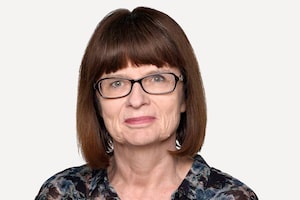Native protesters rise a banner during a blockade at the VIA train tracks and Wyman's Road near Shannonville, Ont., on Wednesday March 19, 2014.The Canadian Press
A constant challenge for all journalists is to be as knowledgeable as you can possibly be on whatever subject you are covering. The more you know, the better the question you can ask, and the more intelligent the work on any subject will be.
One very complex subject is understanding indigenous issues in Canada including the murdered and missing women, residential schools and the Truth and Reconciliation Commission, which reported earlier this month.
Angela Murphy, the senior editor in charge of projects, has been leading a team of reporters working on the murdered and missing women file. Part of her mission has been to spread the knowledge of reporting and coverage beyond her group.
Last week, Dr. Luis Fondebrider, who is working with The Globe, gave a session on searches around the world for missing people. He heads the EAAF (Argentine Forensic Anthropology Team)
The Argentine Forensic Anthropology Team (Equipo Argentino de Antropología Forense, EAAF) is a non-governmental, not-for-profit, scientific organization that applies forensic sciences – mainly forensic anthropology and archeology – to the investigation of human rights violations in Argentina and worldwide. EAAF was established in 1984 to investigate the cases of at least 9,000 disappeared people in Argentina under the military government that ruled from 1976-1983. Today, the team works in Latin America, Africa, Asia and Europe.
On Monday, Miles Kenyon, a journalist from Journalists for Human Rights, a group which offers journalism training to reporters in Africa and Canada, reminded reporters of work being done by Canadian journalists of indigenous descent and pointed to a useful website called Reporting in Indigenous Communities, which offers advice and resources for reporters.
His main advice was to listen, be respectful of their culture, ask people how they want to be identified and include some history in your stories about Canada's obligations in law to the indigenous population.
Since the beginning of the Globe project on Missing and Murdered Indigenous Women, we've been cognizant of not making it about "us" and "them," Ms. Murphy says. "It's an issue that affects Canadian society and should be a concern for all of its citizens. We've also been cognizant of the fact that we need the communities' perspective to inform how we, together, tell the story, so we've created an advisory panel of women from the First Nations, Métis and Inuit communities as well as other experts.
"Being inclusive also means that we need to better understand the ongoing impact of colonization, of the residential school system, of the Indian Act. Having the training from Journalists for Human Rights and from NGOs that work on the issue of femicide and missing and murdered indigenous peoples in other parts of the world are steps in an ongoing process of educating ourselves as journalists and Canadians."
 Sylvia Stead
Sylvia Stead